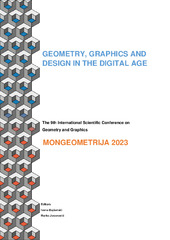Приказ основних података о документу
Encoding/Decoding Capitals of Classical Architectural Orders by Using Fractal Geometry: Establishing Methodology
| dc.creator | Mitrovic, Djordje | |
| dc.creator | Djordjevic, Djordje | |
| dc.creator | Devetakovic, Mirjana | |
| dc.creator | Djukanovic, Gordana | |
| dc.date.accessioned | 2023-11-25T14:48:18Z | |
| dc.date.available | 2023-11-25T14:48:18Z | |
| dc.date.issued | 2023 | |
| dc.identifier.isbn | 978-86-6022-575-9 | |
| dc.identifier.uri | https://raf.arh.bg.ac.rs/handle/123456789/1628 | |
| dc.description.abstract | In most cases, artefacts are differentiated in terms of style they belong to – mainly visually, not mathematically. So, the main research questions of this study are both how to numerically encode stylistic regularities (peculiarities) as geometric indicators of artefacts morphology and how to decode them, namely to identify architectural style those artefacts belong to. Columns, namely their capitals are chosen as the most distinctive elements among artefacts. To elaborate on the validity of the defined principles of the aim-related methodology, a few representatives (capital samples) from each of three fundamental classical architectural orders (Doric, Ionic, and Corinthian) are used. The subject of this Paper is to establish relevant indicators of capital qualification, capital classification, and thus, referred architectural order identification. The verification of those indicators is performed by processing two sets of capitals contours (that belong to the mutually equidistant transverse and equiangular radial section planes) of each of the selected samples (namely digital 3D models). The narrower research aim is to point out that it is possible to encode not only chosen but also any other capital – by using the mentioned indicators of fractal and non-fractal nature (as a control one). The wider research aim refers to a possibility to identify order a concrete fragment of capital belongs to in terms of recognising it computationally (as confidently as possible from the mathematical probability point of view) based on the established research methodology principles. Finally, it is possible to conclude that changes of the analysed indicators trendlines behaviour (expressed by changes of its slope, roughness, continuation, etc.) accurately/precisely describe morphology-wise variations of a form that could point out subject-related stylistic variation, as well. So, this Paper demonstrates not only the fact that architectural orders capitals are true fractal objects, but rather how fractal analysis as a tool can be used to scientifically numerically encode/decode their certain characteristics (fractal features) of single- or multi-scale nature. | sr |
| dc.language.iso | en | sr |
| dc.publisher | Novi Sad : Faculty of Technical Sciences, University of Novi Sad | sr |
| dc.publisher | Belgrade : Serbian Society for Geometry and Graphics (SUGIG) | sr |
| dc.relation | info:eu-repo/grantAgreement/MESTD/inst-2020/200090/RS// | sr |
| dc.rights | openAccess | sr |
| dc.source | Proceedings / The 9th International Scientific Conference on Geometry, Graphics and Design in the Digital Age, MoNGeomatrija 2023, June 7-10, 2023, Novi Sad, Serbia | sr |
| dc.subject | fractal dimension | sr |
| dc.subject | stylistic encoding/decoding | sr |
| dc.subject | capital qualification | sr |
| dc.subject | capital classification | sr |
| dc.subject | architectural order identification | sr |
| dc.title | Encoding/Decoding Capitals of Classical Architectural Orders by Using Fractal Geometry: Establishing Methodology | sr |
| dc.type | conferenceObject | sr |
| dc.rights.license | ARR | sr |
| dcterms.abstract | Деветаковиц, Мирјана; Дјукановиц, Гордана; Митровиц, Дјордје; Дјордјевиц, Дјордје; | |
| dc.citation.spage | 153 | |
| dc.citation.epage | 167 | |
| dc.identifier.fulltext | http://raf.arh.bg.ac.rs/bitstream/id/5287/bitstream_5287.pdf | |
| dc.identifier.rcub | https://hdl.handle.net/21.15107/rcub_raf_1628 | |
| dc.type.version | publishedVersion | sr |

